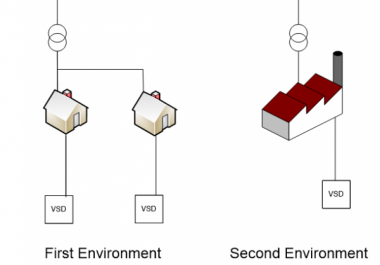Filtering out the noise - Understanding IEC 61800-3 (Part 2)

Part 3 of IEC 61800 specifies electromagnetic compatibility (EMC) requirements for power drive systems (PDSs). These are adjustable speed a.c. or d.c. motor drives. Requirements are stated for PDSs with converter input and/or output voltages (line-to line voltage), up to 35 kV a.c. r.m.s. A detailed definition of a PDS is beyond the scope of this article, so in our case a PDS is an AC variable speed drive – VSD.
VSD’s covered by this standard can range from a few hundred watts to many megawatts, which are installed in residential, commercial or industrial locations (excluding traction applications and electric vehicles)
IEC 61800-3 defines residential and industrial environments as follows:
First Environment
“Environment that includes domestic premises, it also includes establishments directly connected without intermediate transformers to a low-voltage power supply network which supplies buildings used for domestic purposes”. E.g. Houses, apartments, commercial premises or offices in a residential building. An inner city council pump station fed from a local boundary box is a typical example of a first environment installation that is often overlooked.
Second Environment
“Environment that includes all establishments other than those directly connected to a low voltage power supply network which supplies buildings used for domestic purposes”. E.g. Industrial areas, technical areas of any building fed from a dedicated transformer, which is usually adjacent to or inside the industrial location.
Figure 1. Illustration of environment classes
So when selecting your VSD the first step you must take is clearly establishing what type of environment you wish to install and operate it in. The next step is to understand the category classifications to apply within these environments.
The technical brochures of nearly every VSD makes mention of the levels of RFI filtering included within the product. Such documents may make mention of “Class A or class B” filtering or “Restricted and unrestricted” classes of distribution. These classifications have now been replaced by categories of VSD (C1 to C4) with definitions related to the product itself and its intended use. These categories fit within the two environments.
Category C1 – applies to the first environment
“PDS of rated voltage less than 1000 V, intended for use in the first environment”
Basically, this is a device that has been designed by the manufacturer as “ready to use”. It is a domestic device with a plug for first environment use only and can be installed by anyone. An example of this would be the inverter within a domestic heat pump.
Category C2 – applies to first environment
“PDS of rated voltage less than 1000 V, which is hardwired and, when used in the first environment, is intended to be installed and commissioned only by a professional”. A professional is a person or an organization having necessary skills in installing and/or commissioning VSDs, including their EMC aspects.
Also a first environment device, but very different to a C1 device. A C2 device cannot have a plug and must be hardwired as part of an apparatus, system or installation. Typically this is a VSD in a form factor as we normally know it but with internal or external filtering to allow it to be installed in the first environment.
Category C3 – applies to the second environment
“VSD of rated voltage less than 1000 V, intended for use in the second environment only and not the first environment”.
More than 95% of VSD are installed in the industrial environment so have filtering to comply with category C3.
Category C4 – applies to the second environment
“VSD of rated voltage greater than or equal to 1000 V, or rated current greater than or equal to 400 A, or intended for use in complex systems in the second environment”. RF emission of category C4 equipment is only assessed when it is installed in its intended location. It is therefore treated as a fixed installation, for which this standard gives rules of engineering practice, although it gives no defined emission limits (except in case of complaint).
Table 1. C-categories and environments according to IEC 61800-3
All of Power Electronics SD series variable speed drives incorporate RFI filtering. Frame 1 & 2 SD750 series (up to 75kW) fall into the first environment class and C2 category as does the 230V single phase input SD300 range. All other SD series comply with second environment, category C3. It is possible to fit optional external RFI filters or optional internal factory fitted RFI filters to the category C3 SD series VSD’s to meet first environment, category C2.
So next time you specify or install a VSD first, consider the environment - is it first or second? You may need to do some investigation to establish where the supply transformer is. Second, establish what category the VSD must meet. This is typically going to be C2 or C3 for the majority of installations.
Your VSD supplier should be able to advise you what level of RFI filtering their VSD’s have in them to enable you to make the correct selection.
Check our next blog where we will complete this series with an article on how the manufactures rate their levels of EMC compliance. We will explain why two VSD’s that seemingly have the same level of filtering can have very different performance in the real world.
This article has been prepared for information purposes only and is not intended to be an EMC compliance guide. Refer to IEC 61800-3 for detailed information.
Get in touch to find out more.

